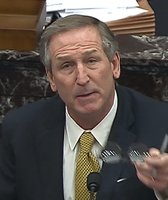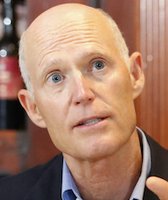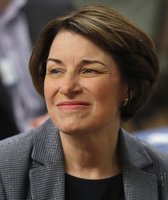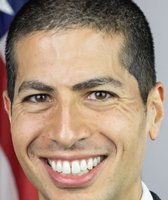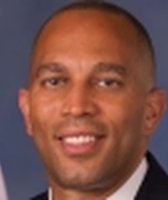Get PolitiFact in your inbox.
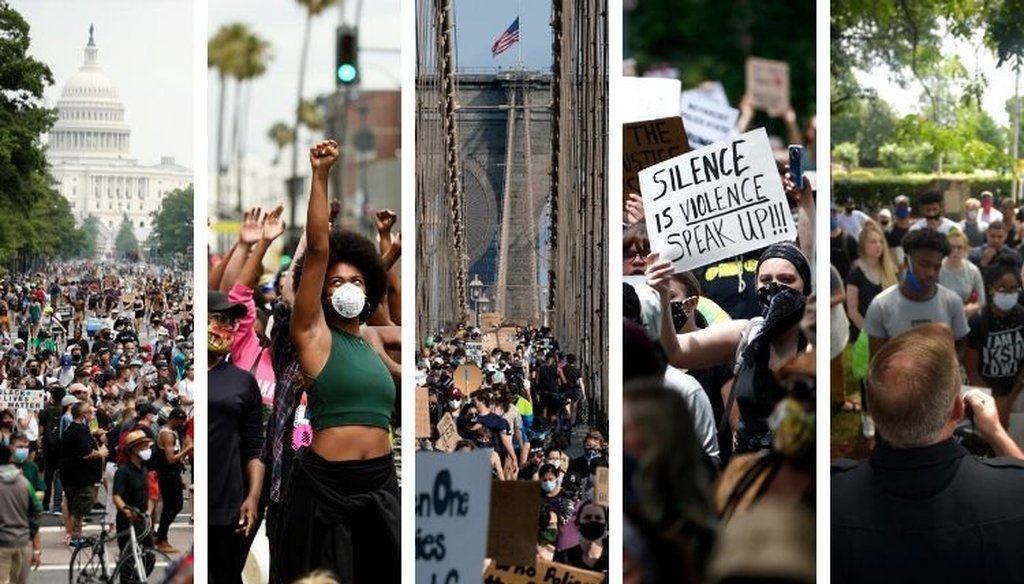
(From left): Protests in Washington D.C., Beverly Hills, Calif., New York City, St. Paul, Minn., and Kennesaw, Ga., during the first weekend of June 2020. (AP)
If Your Time is short
-
Demonstrators in hundreds of cities across the country have protested police brutality against African Americans.
-
Many social media posts and news broadcasts have focused on the violence, looting and property damage at Black Lives Matter protests. But those scenes of destruction don’t tell the whole story.
-
PolitiFact surveyed news reports, statements from public officials and footage in five major American cities to get a feel for the tenor of Black Lives Matter protests. We found that, while all of them started with violence, demonstrations are now largely peaceful.
If you only get your news from Facebook, you might think all Black Lives Matter demonstrations devolve into riots and looting.
Since George Floyd’s death in Minneapolis police custody, PolitiFact has debunked dozens of false claims about protests against police brutality and racism across the country. Some have to do with false rumors of riots. Others take photos and videos out of context to claim that violent protests were planned by shadowy left-wing groups.
Those social media posts, as well as news broadcasts that run early footage of looting alongside live shots of peaceful protests, paint a picture of America in flames. The truth is more complicated.
The New York Times reports that, as of June 8, at least six people have been killed in violence connected to the protests around the country. As of June 4, a tally from the Associated Press counted more than 10,000 arrests. There are also scores of instances of police violence against journalists trying to cover the demonstrations.
RELATED: The death of George Floyd: What you need to know
Sign up for PolitiFact texts
But news reports and police say that violence is not the norm.
"After searching through hundreds of local news reports, the vast majority of these events have been reported as peaceful, and violence seems to be the exception and not the rule," said Mitchell Thorson, a USA Today interactive graphics editor who has helped map hundreds of protests around the country.
We surveyed five major cities to get a better picture of the demonstrations nationwide. For each one, we included hours of live footage from the first weekend of June to give an unfiltered view of the protests.
While several demonstrations started with violence and looting during the last weekend of May, the bulk of the protests became more peaceful.
Minneapolis | New York City | Washington, D.C. | Los Angeles | Atlanta
Minneapolis
Protesters march in Minneapolis, Minn., on June 6, 2020. (KARE)
-
Violent protests in the city where Floyd was killed appear to have peaked between May 27 and 31. Since then, there has been more than a week of largely peaceful demonstrations.
Floyd’s home city reacted to his death with some of the most violent protests in the country.
On Monday, May 25, Floyd died after a white police officer kneeled on his neck outside Cup Foods, a local convenience store, video showed. The next day, protesters began marching outside the store’s location on East 38th Street and the Minneapolis 3rd Police Precinct.
The demonstrations started peacefully, but they got confrontational after protesters spray-painted the precinct and threw rocks at the building’s windows. In response, police fired tear gas and flash grenades.
On May 27, the Minneapolis Police Department released the names of the officers involved in Floyd’s death, all of whom were fired. Violence seems to have peaked in the four days that followed.
Demonstrators set fires and looted businesses. One man shot and killed someone he thought was looting a store. The Star Tribune reported that the violence stood in "stark contrast to the mostly peaceful protests outside of a South Side police station."
On May 28, demonstrators burned down the 3rd Police Precinct and Minneapolis Mayor Jacob Frey declared a state of emergency. Derek Chauvin, the officer who kneeled on Floyd’s neck, was arrested the next day, May 29, on murder and manslaughter charges.
RELATED: How a false claim about out-of-state protesters traveled from Minnesota officials to Trump, Pelosi
But the violence continued. On May 31, a semi-truck almost drove through protesters and more than 10,000 National Guard troops were deployed to Minnesota.
As of June 9, at least 570 businesses in Minneapolis and neighboring St. Paul had been vandalized, looted or otherwise damaged, according to the Star Tribune.
"It showed that some people were not involved in this out of respect for Mr. Floyd but rather for opportunistic motives," said police department spokesman John Elder said in an email.
Protests in June were not as confrontational. More than 1,000 protesters gathered in downtown St. Paul on June 5 to support community control of the police. Demonstrators also gathered outside U.S. Bank Field Stadium in Minneapolis. The next day, thousands more marched through the city to call for defunding the MPD — a plea that most city council members have backed.
The Star Tribune did not report violence at any of the gatherings, and a photo gallery shows crowds peacefully protesting on Friday. Elder said the protests are now "largely peaceful." The Associated Press reported June 7 that police had also started showing less force at protests across the country.
What happened in the Twin Cities set the tone for protests to follow.
New York City
Protesters march in New York City on June 7, 2020. (WNBC)
-
Violent protests appear to have peaked between May 29 and June 2. Since then, there has been a week of largely peaceful demonstrations.
Like Minneapolis, New York City — where tensions have run high since the coronavirus pandemic began — has seen some violence at demonstrations over the death of Floyd. But most recent protests have been peaceful.
Demonstrations began in New York City on May 28, when scuffles between protesters and police at Union Square led to dozens of arrests. Protests in Brooklyn the next day also turned violent as people started throwing bricks and bottles at police and setting cop cars on fire.
As the last weekend of May wore on, the New York Times described protests as starting off "largely peaceful" but later turning into "jarring scenes of flaming debris, stampedes and looted storefronts." In downtown Manhattan, looters targeted dozens of high-end stores in SoHo. In response, the city imposed a curfew for the first time since World War II.
Arrests, looting and clashes with police continued on and off over the next few days.
RELATED: No, the 9/11 Memorial in New York City wasn’t defaced
On June 1, "Black Lives Matter" was spray painted on a statue of George Washington outside the building where he was inaugurated as the first U.S. president. The next day, protesters peacefully demonstrated at the Stonewall Inn, the gay bar that was the site of the riots that sparked the modern LGBTQ rights movement, before a tense encounter with police.
But by the weekend, demonstrations in New York City had become largely peaceful.
On June 5, many buildings in Manhattan were boarded up, although local news outlets reported that looting had ceased to be a major problem in the city. The New York Times described the protests on June 7 as "a night without curfew or conflict." Thousands of protesters marched near Columbus Circle, Union Square and Bryant Park in Manhattan, as well as locations scattered throughout Brooklyn.
"Yesterday and last night we saw the very best of our city," tweeted Mayor Bill De Blasio on June 7, the same day he announced reforms to the New York Police Department.
Washington, D.C.
Protesters march in Washington, D.C., on June 6, 2020. (WUSA)
-
Violent protests appear to have peaked between May 29 and June 1. Since then, there has been a week of largely peaceful demonstrations.
As the violence in Minneapolis was winding down, protests in the nation’s capital were reaching a fever pitch.
On May 29 — the day that Chauvin was arrested — the White House was locked down as demonstrators marched down Pennsylvania Avenue. Protesters threw bottles at Secret Service agents and tried to break through metal barriers outside the residence. Some officers were injured and used pepper spray on the crowd.
The next day, popular monuments around Washington were vandalized with graffiti. The tension boiled over as the night wore on.
Defying a citywide curfew, demonstrators faced off with the law enforcement, broke into offices and set multiple fires around the Washington Monument. Police responded with teargas, pepper spray and rubber bullets. Stores spanning from Michael Kors in Georgetown to CVS Pharmacy near CityCenter were looted.
On June 1, officers fired pepper balls, a product that contains a chemical irritant, at demonstrators to clear the way for Trump’s three-minute photo op at St. John’s Church.
RELATED: Trump falsely claims DC mayor kept police from White House protests
A couple of days later, the largest crowd of the week gathered in front of the White House and marched to the U.S. Capitol. The Washington Post described the gathering as "largely peaceful."
"This past weekend we saw a few bad actors set fires to vehicles and buildings, including a historic church, destroy locally owned and other businesses, and attempt to cause bodily harm by throwing objects at officers," said the Metropolitan Police Department in a June 5 email. "However, over the last few days we have seen peaceful demonstrations without any incident or arrests."
The calm persisted through the first weekend of June.
On June 5, D.C. Mayor Muriel E. Bowser renamed a section of 16th Street in front of the White House "Black Lives Matter Plaza" and authorized the words "Black Lives Matter" be painted on the asphalt in giant yellow block letters. Bowser asked Trump to remove all additional federal law enforcement presence from the city. Thousands of people gathered in the city over the weekend to protest police brutality, and news coverage and live streams indicate they were peaceful.
Los Angeles
Protesters march in Los Angeles on June 6, 2020. (KNBC)
-
Violent protests appear to have peaked between May 27 and June 1. Since then, there has been a week of largely peaceful demonstrations.
After a video of Floyd’s death started to circulate on social media, protesters blocked traffic on the 101 Freeway in downtown L.A. on May 27. Some burned upside-down American flags and vandalized the Los Angeles Police Department headquarters.
Like other major cities, the violence peaked during the last weekend of May. Protests that started peacefully devolved into clashes with police across the city, damaged property in Beverly Hills, torched cop cars in downtown L.A. and looted buildings in Santa Monica.
"L.A. failed tonight," LAPD Chief Michel Moore told reporters on May 29.
Early on May 31, hundreds of National Guard troops patrolled the streets after another night of violence. Thousands of people had marched overnight in cities across L.A. County, with looting concentrated in Santa Monica and Long Beach. Hundreds of people were arrested and five LAPD officers were injured.
For Angelenos, the violent protests recalled memories from 1992, when riots erupted over the acquittal of four white police officers who were filmed beating Rodney King, a black man. Thousands of people were injured and more than 50 died in the violence.
RELATED: Photo shows security barriers in Sherman Oaks, not rocks George Soros supplied for rioters
Protests over Floyd’s death have not resulted in the same number of injuries.
On June 4, after three more Minneapolis police officers were charged with aiding and abetting in Floyd’s killing, demonstrators gathered in several locations around L.A. County, including Burbank, Santa Clarita and downtown L.A. Thousands of peaceful demonstrators turned out on June 6 across L.A. to protest the death of Floyd and other black Americans at the hand of police. Peaceful protests continued through Sunday, culminating in June 7 marches in Compton and on Hollywood Boulevard.
"I’m proud that our city has been peaceful this week — and that our residents are leading a powerful movement to make Los Angeles more just, equitable, and fair for Black Angelenos, communities of color, and all of our workers, youth, and families," said Mayor Eric Garcetti in a statement.
Atlanta
Protesters march in Atlanta on June 6, 2020. (WGCL)
-
Violent protests appear to have peaked between May 29 and 31. Since then, there has been a week of largely peaceful demonstrations.
Like other cities during the last weekend of May, demonstrations devolved as day turned to night.
The Atlanta Journal-Constitution reported that the chaos spanned from Buckhead, an affluent neighborhood north of the city, to downtown, where protesters marched from the state capital to CNN Center. Demonstrators defaced the news network’s sign and threw water bottles, eggs and other items at police.
From there, looters entered the CNN building, and demonstrators threw rocks through hotel windows and set fire to cars near Centennial Olympic Park. Atlanta police used tear gas, and Gov. Brain Kemp deployed National Guard troops to the Lenox Square area.
On the second night of upheaval, some protesters left broken windows and spray painted businesses in their wake, and two police officers were fired after using excessive force during the city’s curfew crackdown. Police continued to use tear gas to contain the crowds.
By the third night, May 31, protests in Atlanta had become mostly peaceful amid a heavy police presence. It lasted for the rest of the week.
WABE reported that June 3 was the first night police did not use tear gas to clear the area around Centennial Olympic Park. Some activists organized a June 4 demonstration in McDonough, a suburb of Atlanta, with input from local police to keep protesters safe.
The relative calm lasted through the first weekend of June, when demonstrations against police brutality stretched from downtown Atlanta to several surrounding suburbs. The city’s overnight curfew was lifted. Thousands of people marched for the 10th day in a row on June 7 without reports of violence or looting.
"The ‘City Too Busy To Hate’ continued its streak of peaceful protests with the Atlanta Police Department reporting zero arrests for the entire weekend," WABE reported.
Now more than ever, it’s important to sort fact from fiction. Please donate to support our mission. Membership.politifact.com
Our Sources
ABC 7, "George Floyd protests updates: More protests in NYC Monday after peaceful, arrest-free night," June 8, 2020
ABC 7, "Protests in George Floyd's death turn violent in Brooklyn; cops injured, hundreds arrested," May 29, 2020
Associated Press, "AP tally: Arrests at widespread US protests hit 10,000," June 4, 2020
Associated Press, "Police show less force as peaceful protests push reform," June 7, 2020
The Atlanta Journal-Constitution, "Atlanta protests: Peaceful rallies held in cities across metro Atlanta," June 6, 2020
The Atlanta Journal-Constitution, "No curfew and a city at ease at protests Saturday night," June 6, 2020
The Atlanta Journal-Constitution, "Police enforce curfew as protesters gather for third day in Atlanta," May 31, 2020
The Atlanta Journal-Constitution, "Protest turns into hours of chaos, violence in Atlanta," May 30, 2020
The Atlanta Journal-Constitution, "Second day of Atlanta protests ends with property damage, 157 arrests," May 31, 2020
The Atlanta Journal-Constitution, "Thousands march as protests continue for 10th day across metro Atlanta," June 7, 2020
The Atlanta Journal-Constitution, "Two Atlanta officers fired for using excessive force, mayor says," May 31, 2020
Bellingcat and the Guardian, "Police Violence Against Journalist At Protests Across The U.S.," accessed June 8, 2020
CBS 2, "At Least 40 Arrests Made At Union Square Protest Over George Floyd’s Death," May 28, 2020
CBS 2, "De Blasio Announces Several NYPD Reforms, Including Shifting Funding From Police To Youth Services," June 7, 2020
CBS 4, "‘It’s Real Ugly’: Protesters Clash With Minneapolis Police After George Floyd’s Death," May 26, 2020
CNBC, "‘We’re built up with frustration’: Scenes and sounds in NYC during 3 days of protest against police brutality," June 6, 2020
CNN, "Famed DC monuments defaced after night of unrest," May 31, 2020
CNN, "June 4 George Floyd protest news," June 5, 2020
CNN, "Looters were able to target high-end stores in New York due to an intelligence failure, NYPD official says," June 6, 2020
CNN, "May 30 George Floyd protests news," May 31, 2020
CNN, "Trump briefly taken to underground bunker during Friday's White House protests," June 1, 2020
Email from John Elder, director of the Office of Public Information at the Minneapolis Police Department, June 8, 2020
Email from the Metropolitan Police Department, June 5, 2020
Email from Mitchell Thorson, USA Today interactive graphics editor, June 5, 2020
Fox 9, "Fires set, businesses looted and 1 man killed as George Floyd protests turn violent in Minneapolis," May 27, 2020
Fox 9, "Protesters throw rocks, damage Minneapolis Police vehicles at 3rd precinct protest," May 26, 2020
The Guardian, "Fires light up Washington DC on third night of George Floyd protests," June 1, 2020
KABC, "George Floyd protests continue in Los Angeles, across Southern California," June 6, 2020
KABC, "National Guard patrols Los Angeles to help quell chaos following violent protests, looting," May 31, 2020
KNBC, "Images: Violence Flares Up on the Streets of Los Angeles," May 30, 2020
Los Angeles Sentinel, "A Timeline of the George Floyd Protests in L.A.," June 4, 2020
Los Angeles Times, "From Compton to Hollywood Boulevard, protests keep growing around L.A.," June 7, 2020
Los Angeles Times, "‘It’s worse today than it was back then’: Watching Minneapolis, some Angelenos recall Rodney King," May 30, 2020
Los Angeles Times, "The L.A. Riots: 25 years later," April 26, 2017
Los Angeles Times, "Looting hits Long Beach, Santa Monica as countywide curfew goes into effect," May 31, 2020
Los Angeles Times, "Looting, vandalism across downtown L.A. as protesters, police clash," May 29, 2020
Los Angeles Times, "Protesters, law enforcement clash in downtown L.A. during protest over George Floyd’s death," May 27, 2020
Los Angeles Times, "Thousands turn out for peaceful demonstrations on Saturday around Los Angeles," June 6, 2020
Minneapolis Star Tribune, "As Mayor Frey calls for officer's arrest, violence intensifies in Minneapolis," May 28, 2020
Minneapolis Star Tribune, "Businesses damaged in Minneapolis, St. Paul after riots," June 5, 2020
Minneapolis Star Tribune, "Minneapolis Mayor Frey tells 'DefundMPD' marchers he favors reforms over disbanding," June 7, 2020
Minneapolis Star Tribune, "Most of Minneapolis City Council pledges to 'begin the process of ending' Police Department," June 8, 2020
Minneapolis Star Tribune, "Protests continue in the name of George Floyd in Minneapolis and St. Paul," June 6, 2020
Minneapolis Star Tribune, "Protests continue in Twin Cities as hundreds gather outside Keith Ellison's office and at U.S. Bank Stadium," June 5, 2020
Minnesota Daily, "The last days of May: A visual timeline of the George Floyd Protests," June 4, 2020
NBC 4, "DC Ceremonially Names Street to White House After Black Lives Matter; Emblazons Name on Road," June 5, 2020
The New York Post, "‘Hundreds’ of looters rush into Macy’s Herald Square store," June 2, 2020
The New York Times, "George Floyd Protests: A Timeline," June 3, 2020
The New York Times, "In New York Protests, a Night Without Curfew or Conflict," June 8, 2020
The New York Times, "N.Y.C. Protests Turn Violent," May 31, 2020
The New York Times, "Protests Near White House Spiral Out of Control Again," May 31, 2020
NPR, "George Floyd's Arresting Officer Charged With 3rd-Degree Murder, Manslaughter," May 29, 2020
PolitiFact, "Barr says federal police didn’t use chemical irritants to clear area by DC church. They did," June 8, 2020
PolitiFact, "Black Lives Matter activists are not planning riots in Fresno," June 2, 2020
PolitiFact, "Fact-checking theories about bricks and Black Lives Matter protests," June 3, 2020
PolitiFact, "Only one of the sites in these photos was damaged during demonstrations, and it was a bathroom," June 4, 2020
PolitiFact, "Photo shows security barriers, not rocks George Soros supplied for rioters," June 2, 2020
PolitiFact, "The death of George Floyd: What you need to know," May 29, 2020
PolitiFact, "Vietnam memorial was not vandalized by Black Lives Matter protesters," June 4, 2020
Statement from Los Angeles Mayor Eric Garcetti, June 7, 2020
Tweet from Bill De Blasio, June 7, 2020
Tweet from Brian Stelter, June 5, 2020
Tweet from Mandy Jenkins, June 4, 2020
Tweet from Muriel Bowser, June 5, 2020
USA Today, "Tracking protests across the USA in the wake of George Floyd's death," accessed June 5, 2020
USA Today, "White House was locked down as protests over Floyd's death reach nation's capital," May 29, 2020
Voice of America, "Minnesota Calls National Guard to Quell Violent Protests in Minneapolis," May 29, 2020
Vox, "Officers fire tear gas on peaceful protesters to clear the way for Trump’s photo op," June 1, 2020
WABE, "A Weekend Of Peaceful Protests With No Arrests In Atlanta," June 7, 2020
WABE, "Protests Over George Floyd's Death Continue In Atlanta," June 4, 2020
The Wall Street Journal, "Thousands of Protesters in D.C., Nationwide Decry Police Abuse," June 7, 2020
WUSA, "Dozens of DC businesses looted, CityCenter and Georgetown see significant damage," May 31, 2020
YouTube video from ABC 7, June 5, 2020
YouTube video from CBS News, May 31, 2020
YouTube video from Global News, June 6, 2020
YouTube video from KTLA, May 31, 2020
YouTube video from Ruptly, June 6, 2020
YouTube video from WUSA, June 6, 2020










